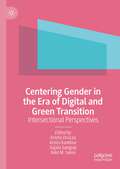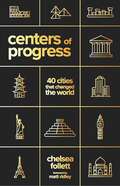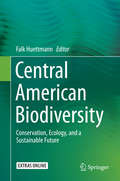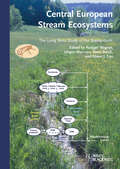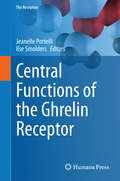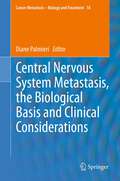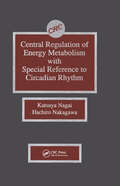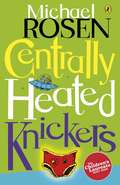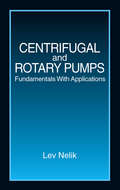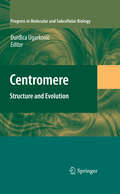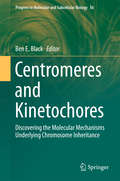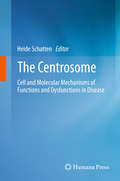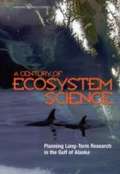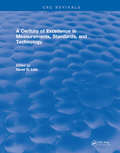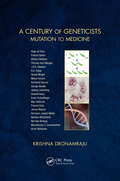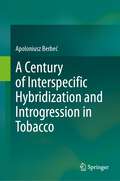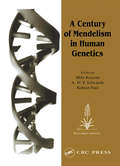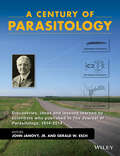- Table View
- List View
Centering Gender in the Era of Digital and Green Transition: Intersectional Perspectives
by Kristie Drucza Amira Kaddour Sujata Ganguly Adel M. SareaThis edited volume examines the importance of centering gender in research and policymaking focused on climate change, environmental sustainability, and digital technology. Chapters unpack how the transition to a green and digital future affects various fields and industry sectors including STEM, agriculture, and energy, as well as why gender-transformative approaches—particularly the production and analysis of gender-inclusive disaggregated data—should be included in those transitions. The editors and authors also look at the positive impact of these considerations on economic growth and poverty eradication. Finally, this book presents an ideal/utopian view of what a gender-equal and inclusive world that has transitioned to green industries and embraced digital technologies might look like.This book will be of interest to scholars, researchers, students and policymakers across the Social Sciences including Sociology, Anthropology, Gender Studies, Science & Technology Studies, and Economics.
Centers of Progress: Forty Cities that Changed the World
by Chelsea FollettWhere does progress happen? The story of civilization is the story of the city. It is cities that have created and defined the modern world by acting as the sites of pivotal advances in culture, politics, science, technology, and more. There is no question that certain places, at certain times in history, have contributed disproportionately toward making the world a better place. This book tells the story of 40 of those places. <p><p>In Centers of Progress: 40 Cities That Changed the World, Chelsea Follett examines a diverse group of cities, ranging from ancient Athens to Song-era Hangzhou. But some common themes stand out: most cities reach their creative peak during periods of peace; most centers of progress also thrive during times of social, intellectual, and economic freedom, as well as openness to intercultural exchange and trade; and centers of progress tend to be highly populated. Because, in every city, it is ultimately the people who live there who drive progress forward―if given the freedom to do so. <p><p>Identifying common factors―such as relative peace, freedom, and multitudes―among the places that have produced history's greatest achievements is one way to learn what causes progress. Change is a constant, but progress is not. Understanding what makes a place fertile ground for progress may help to sow the seeds of future innovations. <p><p>Moreover, their story is our story. City air provides the wind in the sails of the modern world. Come journey through these pages to some of history's greatest centers of progress.
Central American Biodiversity: Conservation, Ecology, and a Sustainable Future
by Falk HuettmannThis book highlights key results and lessons learnt from two field sites, La Suerte in Costa Rica and Ometepe Nicaragua. It provides long term data on species abundance and distribution. Primates receive specific attention in this book, as they are flagship species and good indicators for the "health" of an ecosystem, but as well a money maker. Many primate species are sensitive to habitat alteration, and are often hunted out first. But they play an important role as seed dispersal agents for the regeneration of the forest. The book then compares results from the two field sites with regional trends, and explores potential solutions such as REDD+. This book strongly calls for new approaches in conservation, it makes the case for looking beyond the pure species biology and classic conservation angle and to take into account the economic and political realities.
The Central Appalachians: Mountains of the Chesapeake
by Mark Hendricks--The book will be the first to specialize on the Appalachians of the Chesapeake Bay Watershed. --Interspersed amongst seasonal portfolios of images will be stories of characters- scientists, conservationists and a thru hiker on the Appalachian Trail. No other project on these ancient mountains has used traditional photography as well as camera trapping, underwater photography, and drones to attempt to tell a complete story. --Tourism is booming in the mountains and this could be an important compilation for the four states that it documents
Central European Stream Ecosystems: The Long Term Study of the Breitenbach
by Wagner Jürgen Marxsen Peter Zwick Eileen J. CoxProbably the best-studied stream on earth. The result of unmatched long-term data taken by the Max-Planck outstation in Schlitz from the nearby Breitenbach stream since 1949, the special focus in this handbook and ready reference is on animal and microorganism occurrence and variation, as well as chemical and physical parameters. An invaluable data basis for modeling purposes for anyone dealing with stream ecology.
Central Functions of the Ghrelin Receptor (The Receptors #25)
by Jeanelle Portelli Ilse SmoldersThe Ghrelin receptor was identified before its natural ligand ghrelin. This receptor is found both centrally and peripherally, and has been shown to affect various processes, such as food intake, gut motility, memory, glucose and lipid metabolism, cardiovascular performances, reproduction, memory, and immunological responses, amongst others. The functions of the ghrelin receptor in the central nervous system are numerous and are still being explored. In this book we specifically focus on the various roles of the ghrelin receptor in the central nervous system. In a first set of chapters, the book will focus on the discovery and the properties of this intriguing constitutively active G-protein coupled receptor, on its multiple intracellular transduction mechanisms and the various subtypes of the currently known ghrelin receptor complexes. Next, the book will elaborate on the mitochondrial mechanisms regulated by the ghrelin receptor, its role in feeding and drug addictive mechanisms, memory, sleep and arousal. The final chapters focus on the potential of this receptor as a target for the treatment of neurological disorders including Parkinson's disease, epilepsy, anxiety and depression.
Central Nervous System Metastasis, the Biological Basis and Clinical Considerations (Cancer Metastasis - Biology and Treatment #18)
by Diane PalmieriHere is a thorough survey of the biology and treatment of CNS metastasis, including natural history, risk factors, molecular biology, the blood-brain barrier, imaging, quality of life, surgery, chemotherapy, radiation and the future of targeted therapies.
Central Park Zoo, The
by Joan ScheierCountless New Yorkers, as well as visitors from all parts of the world, have experienced an oasis just a few feet off Fifth Avenue in the heart of Manhattan. Since the 1860s, Central Park has been the home of three different zoos: the menagerie, the zoo of 1934, and what is today known as the Central Park Zoo. The Central Park Zoo begins with the menagerie of the 1860s, an impromptu public zoo begun when citizens and circuses started donating animals to the city. It continues in 1934, when Robert Moses-perhaps the most influential man in the city's planning history-built a newer zoo, remembered to this day for its lions, tigers, elephants, and gorillas. It ends with the brand new zoo and exhibits built in 1988 under the supervision of the Wildlife Conservation Society. With stunning, rarely seen images, The Central Park Zoo not only is a treat for the eyes but also comes alive with the barking of sea lions, the soft fur of snow monkeys, the sweet smell of peanut butter, and the taste of "ice cakes"-treats for the zoo residents, of course.
Central Regulation of Energy Metabolism With Special Reference To Circadian Rhythm
by Katsuya NagaiThis excellent book describes the roles of the suprachiasmatic nucleus (SCN) of the hypothalamus as a regulatory center of homeostatic mechanism and a circadian oscillator in mammals, including humans. The authors emphasize two important points based on their findings: 1) SCN plays a critical role in central regulation of energy metabolism through which a constant supply of glucose to the central nervous system (CNS) is well maintained; and 2) neurons responsible for the regulation of energy metabolism are located in the ventrolateral part of the SCN and receive retinal neural inputs through both the retinohypothalamic tract and the geniculohypothalamic tract. The authors then discuss the evolutionary importance of these points to the survival of mammals on earth. Other topics examined include the involvement of light in the regulation of neural activity of the autonomic nervous system through the retina and SCN, in addition to the relation of the SCN with regulations of other autonomic nerve functions, such as blood pressure and body temperature. Central Regulation of Energy Metabolism with Special Reference to Circadian Rhythm is important reading for researchers and students in neuroendocrinologists, neurobiologists, biochemists, endocrinologists, physiologists, chronobiologists, psychologists, pharmacologists, and others interested in the topic.
Centrally Heated Knickers
by Michael RosenHail! Hail!I come from anothergalaxy.Discover the wierd and wonderful world of martians, woolly saucepans and centrally heated knickers in 100 poems about science and technology from the delightfully irreverent, Michael Rosen, Children's Laureate 2007 - 2009.
Centrifugal Pump Clinic, Revised and Expanded (Mechanical Engineering #68)
by Igor J. KarassikMaintaining the excellent coverage of centrifugal pumps begun in the First Edition -- called ``useful'' and ``indispensable'' by reviewers -- the Second Edition continues to serve as the most complete and up-to-date working guide yet written for plant and design engineers involved with centrifugal pumps.
Centrifugal Pumps for Sodium Cooled Reactors
by Ravindra Kale B.K. ShreedharThis comprehensive introduction to centrifugal pumps used in sodiumcooled fast reactors discusses the special attributes of centrifugal pumps, design features, manufacturing requirements, instrumentation, and operating experience. It covers the characteristics of mechanical pumps, used as the main coolant pumps in fast reactors. Key Features: • Covers description of pumps in various reactors highlighting the special features of the pumps and providing an overview of futuristic design concepts. • Discusses the aspects related to the design, manufacture, testing, instrumentation, and operating experience of centrifugal sodium pumps. • Highlights the challenges in centrifugal sodium pump testing. • Presents topics such as cavitation testing for critical applications and thermodynamic effect on pump cavitation. • Real-life case studies are included for better understanding. This book gives a detailed overview of the design, manufacture, testing, and operating experience of the main coolant pumps used in sodium-cooled nuclear reactors. It further discusses the special type of pumps used in fast reactor power plants to circulate liquid sodium through the core. The text examines the challenges in centrifugal sodium pump testing and types of test facilities around the world. Real-life examples are used to highlight important aspects. It is primarily written for senior undergraduate, graduate students, and academic researchers in the fields such as mechanical engineering, nuclear engineering, and chemical engineering.
Centrifugal & Rotary Pumps: Fundamentals With Applications
by Lev NelikCentrifugal and Rotary Pumps offers both professionals and students a concise reference detailing the design, performance, and principles of operation of the different pumps types defined by the Hydraulic Institute. From historical background to the latest trends and technological developments, the author focuses on information with real-world prac
Centromere: Structure and Evolution (Progress in Molecular and Subcellular Biology #48)
by Durdica UgarkovicThe centromere is a chromosomal locus that regulates the proper pairing and segregation of the chromosomes during cell division. Despite their conserved, essential function, centromeres are characterized by the rapid evolution of both centromeric DNA and proteins. This book presents current views on centromere structure and identity. It deals with the epigenetic concept of centromere establishment and maintenance as well as with the role of DNA and centromeric transcripts in centromere formation and function. Special emphasis is placed on centromere evolution: different evolutionary models are discussed in detail and the latest research on the evolution of new centromeres and neocentromeres is presented.
Centromeres and Kinetochores: Discovering the Molecular Mechanisms Underlying Chromosome Inheritance (Progress in Molecular and Subcellular Biology #56)
by Ben E. BlackThis book presents the latest advances concerning the regulation of chromosome segregation during cell division by means of centromeres and kinetochores. The authors cover both state-of-the-art techniques and a range of species and model systems, shedding new light on the molecular mechanisms controlling the transmission of genetic material between cell divisions and from parent to offspring. The chapters cover five major areas related to the current study of centromeres and kinetochores: 1) their genetic and epigenetic features, 2) key breakthroughs at the molecular, proteomic, imaging and biochemical level, 3) the constitutive centromere proteins, 4) the role of centromere proteins in the physical process of chromosome segregation and its careful orchestration through elaborate regulation, and 5) intersections with reproductive biology, human health and disease, as well as chromosome evolution. The book offers an informative and provocative guide for newcomers as well as those already acquainted with the field.
The Centrosome
by Heide SchattenThe Centrosome: Cell and Molecular Mechanisms of Functions and Dysfunctions in Disease includes chapters on classic and modern aspects of centrosome research to cover topics of current interest that have not been covered in depth in most books on the market so far. It extends on previous topics and includes new exciting aspects of centrosome research focused on primary cilia and their dysfunctions that are implicated in numerous diseases. Each chapter will be written by experts in their fields who will contribute their unique expertise in specific research fields and include cell and molecular details that are important for the specific subtopics. The book will be comprehensive, concise and will include reviews of key topics in the field. Cutting edge new information will be balanced with background information that will be readily understandable for the newcomer and the experienced centrosome researcher alike.
The Centrosome and its Functions and Dysfunctions (Advances in Anatomy, Embryology and Cell Biology #235)
by Heide SchattenThe book provides a comprehensive overview of classic and modern approaches of centrosome research, including new aspects of centrosome functions focusing on primary cilia and their implications in numerous diseases. In addition, several chapters raise awareness of centrosomes in areas that have not yet fully considered the centrosome as an organelle that impacts other organelle functions directly or indirectly. It further relates centrosome functions to other research areas such as aging and stem cell research. Since its discovery almost 150 years ago the centrosome is increasingly being recognized as a most impactful organelle for its role, not only as primary microtubule organizing center (MTOC) but also as a major communication center for signal transduction pathways and as a center for proteolytic activities. Its significance for cell cycle regulation has been well studied and we now also know that centrosome dysfunctions are implicated in numerous diseases and disorders including cancer, cystic diseases of the kidney, liver fibrosis, cardiac defects, obesity and several other diseases and disorders. This new volume reviews the latest advances in the field and provides valuable background information that is readily understandable for the newcomer and the experienced centrosome researcher alike. Due to the interdisciplinary of the subject, it is a valuable resource for researchers and clinicians working in biomedical research, cell biology, cancer biology, reproduction and developmental biology, neuroscience and stem cell research.
A CENTURY OF ECOSYSTEM SCIENCE: Planning Long-Term Research in the Gulf of Alaska
by Committee to Review the Gulf of Alaska Ecosystem Monitoring ProgramThis report provides guidance to the Gulf Ecosystem Monitoring (GEM) program to help ensure that it is based on a a science plan that is robust, far-reaching, and scientifically sound. The report commends the Trustee Council for its foresight in setting aside funds to create a trust fund to provide long-term research support; it notes that the GEM program offers an unparalleled opportunity to increase understanding of how large marine ecosystems function and change over time. The report outlines elements of a sound long-term science plan, including conceptual foundation, scope and geographic focus, organizational structure, community involvement, data and information management, and synthesis, modeling, and evaluation.
A Century of Excellence in Measurements, Standards, and Technology
by David R. LideEstablished by Congress in 1901, the National Bureau of Standards (NBS), now the National Institute of Standards and Technology (NIST), has a long and distinguished history as the custodian and disseminator of the United States' standards of physical measurement. Having reached its centennial anniversary, the NBS/NIST reflects on and celebrates its first century with this book describing some of its seminal contributions to science and technology. Within these pages are 102 vignettes that describe some of the Institute's classic publications. Each vignette relates the context in which the publication appeared, its impact on science, technology, and the general public, and brief details about the lives and work of the authors.The groundbreaking works depicted include:A breakthrough paper on laser-cooling of atoms below the Doppler limit, which led to the award of the 1997 Nobel Prize for Physics to William D. PhillipsThe official report on the development of the radio proximity fuse, one of the most important new weapons of World War IIThe 1932 paper reporting the discovery of deuterium in experiments that led to Harold Urey's1934 Nobel Prize for ChemistryA review of the development of the SEAC, the first digital computer to employ stored programs and the first to process images in digital formThe first paper demonstrating that parity is not conserved in nuclear physics, a result that shattered a fundamental concept of theoretical physics and led to a Nobel Prize for T. D. Lee and C. Y. Yang "Observation of Bose-Einstein Condensation in a Dilute Atomic Vapor," a 1995 paper that has already opened vast new areas of research A landmark contribution to the field of protein crystallography by Wlodawer and coworkers on the use of joint x-ray and neutron diffraction to determine the structure of proteins
A Century of Geneticists: Mutation to Medicine
by Krishna DronamrajuGenetics, like all scientific disciplines, is a human endeavor. Thus, the lives of geneticists - their friendships, colleagues and associations - play an important role in the historical development of the science. This book summarizes the history of genetics by reviewing the lives of the prominent and influential researchers beginning with the earliest and simplest branches of genetics (studies of inheritance and mutation) and ending with the human genome project - the pinnacle of genetics research of the 20th century. Key selling features: Summarizes the lives of important genetics researchers Reviews the development of important foundational concepts Highlights the way new technologies and methods have advanced the study of genetics Explores the influence of genetics in other biomedical fields Avoids simplistic chronological summary of genetics
A Century of Interspecific Hybridization and Introgression in Tobacco
by Apoloniusz BerbećThis is the first comprehensive monograph dedicated to using Nicotiana species for tobacco genetic improvement. Unlike typical chapters constrained by size and scope, this book offers a detailed species-by-species analysis, with 27 tables providing relevant information. It marks a shift from focusing on specific topics to giving due attention to individual species. The review reflects on a century of exploiting Nicotiana species for usable germplasm and serves as an exhaustive guide to global literature on the subject, citing nearly 1000 literature items.The review delves into the involvement of Nicotiana species in interspecific hybrids with cultivated tobacco, covering sexual and asexual methods, including grafting. It addresses challenges in hybridization, such as cross incompatibility, maternal phenotypes, interspecific incongruity, lethality, and sterility, providing methods to overcome these barriers. Records on disease resistance for each Nicotianae species are compiled, and mechanisms of introgression, barriers, and limitations are discussed. The book lists Nicotiana species as successful donors of cytoplasmic genetic factors leading to cytoplasmic male sterility (CMS) and discusses negative effects of alien cytoplasm, providing a list of agronomically acceptable CMS sources. Controversial issues, including the identity of genetic accessions, are explored. The book concludes with an updated list of all reported interspecific combinations for Nicotiana.Primarily aimed at scholars and students interested in the genus for genetic diversity, this book serves as a historical reference guide to the realized and potential uses of Nicotiana species in tobacco improvement.
A Century of Mendelism in Human Genetics
by Milo Keynes A.W.F. Edwards Robert PeelIn 1901 William Bateson, Professor of Biology at Cambridge, published a renewed version of a lecture which he had delivered the year before to the Royal Horticultural Society in London (reprinted in the book as an appendix). In this lecture he recognized the importance of the work completed by Gregor Mendel in 1865, and brought it to the notice of
A Century of Nobel Prize Recipients: Chemistry, Physics, and Medicine
by Francis LeroyCelebrating a century of revolutionary contributions to our understanding of life, the world, and the universe, this encyclopedic desk reference traces the discoveries that earned nearly 500 distinguished scientists Nobel honors in the areas of chemistry, physics, and medicine. The School of Library Journal called it "...eye-catching... Original ar
A Century of Parasitology
by John Janovy Jr. Gerald W. EschReviews key areas in ecological, medical and molecular parasitology Features essays from some of the world's leading parasitologists Each topic is set in context by featuring a key paper from the Journal of Paraistology over the past 100 years
A Century of Plant Virology in India
by Bikash Mandal Govind Pratap Rao Virendra Kumar Baranwal Rakesh Kumar JainThe book is a compilation of research work carried out on plant viruses during past 100 years in India. Plant viruses are important constraints in Indian agriculture. Tropical and sub-tropical environments and intensive crop cultivation practices ideally favours perpetuation of numerous plant viruses and their vectors in India, which often cause wide spread crop losses. Of all the plant pathogens, studies of plant viruses have received a special attention as they are difficult to manage. A large body of literature has been published on the plant virus research from India during past 100 years; however the information is so far not available in one place. This book provides comprehensive information on the biology, molecular biology, epidemics, crop losses, diagnosis and management of viruses and viroids occurring in India. Description of properties of the viruses are provided in the chapters comprising of different genera such as Allexivirus, Begomovirus, Babuvirus, Badnavirus, Carlavirus, Carmovirus, Cucumovirus, Closterovirus, Ilavirus, Mandrivirus, Potyvirus, Tospovirus, Tungrovirus and Sobemovirus. Virus-vector research related to aphid, thrips and whitefly is discussed. The work on the management aspects of plant viral diseases has been described with reference to the conventional, antiviral and transgenic approaches. Further, the quarantine mechanism developed in India for the exclusion of viruses and vectors has also been included. The book also provides useful information about the capacity building on the research and education on Plant Virology in India. Overall, the book covers a wide range of accounts of research findings and innovations in Plant Virology in India during past 100 years. The book will be a resourceful reference to the students, scientists, agricultural professionals and policy makers.
